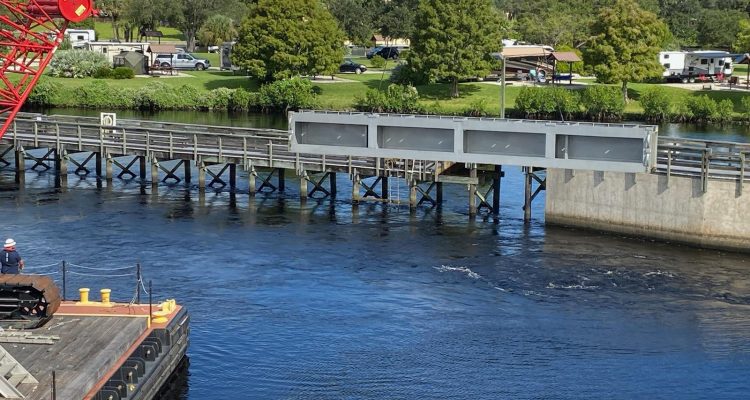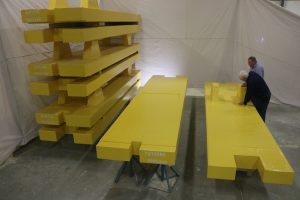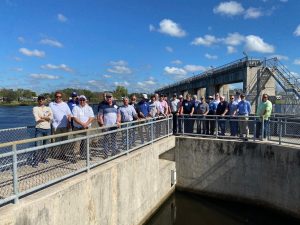The foam core is covered by GFRP fabric to create a bidirectional internal grid. “This is the same configuration we use in vehicle bridges and Navy structures,” says Reeve. “It’s a great way to make sandwich structures that are high strength and durable.”
After the success of the demonstration gates, the USACE decided to move to a production version of the wicket gates. It put out an indefinite duration/indefinite quantity (IDIQ) contract for up to 220 wicket gates, with 114 purchased from CCG’s Augusta, Maine, facility.
These wicket gates and the quoin blocks being made by Orenco Composites are not the only ongoing composite projects with the Army Corps. Other contracts that have been awarded or are slated to go out for bid this year include 20-foot-long dewatering bulkhead stoplogs for the Wilmington, N.C., district, a 30-foot x 10-foot wicket gate for the Olmsted Lock and Dam in Kentucky and a 30-foot-high sector gate with a 50-foot radius for a lock near Cape Canaveral, Fla.
The ERDC is developing a roadmap to ascertain all the potential navigation FRP applications. The possibilities are wide-ranging, from trash racks that keep garbage out of the water near locks to guide walls where vessels line up to enter locks.
“We have a lot of timber guide walls, but sometimes the flow conditions aren’t great, and vessels ram into those walls,” says Johnson. “There’s a lot of damage to the walls, and they are hard and expensive to replace. So, we are looking at using FRP pipe piles and beams to replace those timber guide walls.”
Advice for Moving into the Market
Germann and Johnson believe that many companies in the composites industry are poised to work with the Corps.
“Most of our structures hold back water, but they really resemble a bridge turned on its side,” says Johnson. “So, if a company is making pedestrian bridges or other structures like that, then it’s not that a big leap to move into the products we need.”
Here are some high-level considerations:
- Get to know the Corps. “We are an emerging customer for composites companies,” says Germann. “Like any customer, we have our own language and processes. So, companies need to be adaptive and in tune with how we design and contract out our work.”
Keep an eye out at acmanet.org for more opportunities to connect with the USACE like the February event in Florida. You can also sign up for notices of contracts in the market at sam.gov using the keywords “Army Corps of Engineers” and “FRP.”
- Offer education to engineers. While Germann and Johnson are championing the use of FRP within the USACE, engineers at each of its districts may not be as versed with the material. “There are multiple areas and people within the Army Corps that have to become comfortable with composites,” says Reeve.
CCG has held lunch-and-learn events to introduce USACE employees to FRP, share case studies, discuss design and engineering considerations, and more. The Army Corps also began holding design charettes last year for its employees to share information on composite materials and solutions.
- Design for durability. Hota GangaRao, a civil and environmental engineering professor and director of the Constructed Facilities Center at West Virginia University, began designing and building prototypes of composite wicket gates for the Army Corps in 2012. “It’s been a long road, and I would love to see the composites industry take over mass manufacturing of wicket gates,” he says. But he stresses that quality design and production are paramount.
Durability is a key design consideration, says GangaRao. He offers a handful of suggestions for ensuring durability: Account for knock-down factors in the design, use high quality resins that are forgiving in harsh environments, ensure there are no high stress concentrations at re-entrant angles and pay attention to curing to enhance longevity.
- Be prepared to test your products. “With steel, you can use the American Institute of Steel’s construction manual to design a structure. Those books aren’t available yet for composites, and it scares engineers to some degree,” says Alex Thibodeau, director of operations for CCG’s Augusta facility. “That’s why they require mechanical testing.”
When the facility manufactured wicket gates for the Army Corps under its most recent contract, it sent two of them to the company’s Dayton location for tensile, flexural, impact and other testing. The testing was flawless, says Thibodeau. But he cautions composites companies that testing takes time and money.
- Gain experience in resin infusion. “Unless somebody comes up with a new process for large structures, then vacuum infusion is the process to use,” says Thibodeau. “You need to understand the process really well.”
Successful production requires a large facility, good engineering horsepower and experienced fabricators, he adds.
“This is a great opportunity for the entire composites industry,” says Reeve. “The U.S. Army Corps of Engineers is a large customer that has evaluated composites and is moving ahead with the material. We have to make sure we take care of them.”
Susan Keen Flynn is managing editor of Composites Manufacturing magazine. Email comments to sflynn@keenconcepts.net.
Employees at Creative Composites Group’s Augusta, Maine, facility examine GFRP wicket gates prior to shipment to the Peoria Lock and Dam.
Photo Credit: Creative Composites Group
Representatives from 16 companies throughout the composites’ supply chain visited the W.P. Franklin Lock and Dam in February. ACMA’s Composites Growth Initiative sponsored the event.
Photo Credit: ACMA




